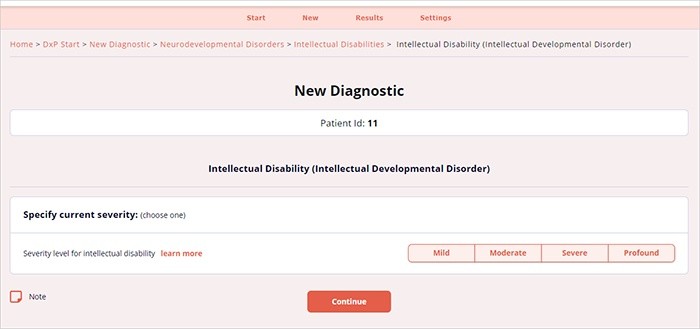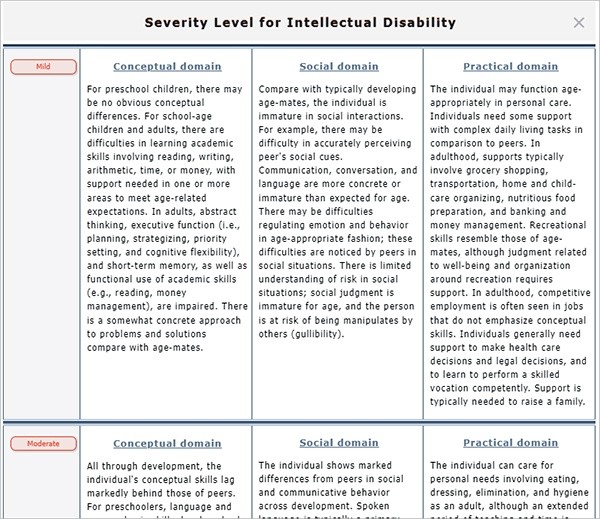|
<< Click to Display Table of Contents >> Specifiers |
  
|
|
<< Click to Display Table of Contents >> Specifiers |
  
|
Specifiers provide an opportunity to define a more homogeneous sub-grouping of individuals with the disorder who share certain features (e.g., major depressive disorder, with mixed features) and to convey information that is relevant to the management of the individual's disorder. The specifiers add valuable clinical information to the diagnosis and in some cases are coded with a unique ICD-10-CM. Not all disorders include course, severity, and/or descriptive features specifiers.
Where applicable in the DxP, , the diagnosis specifiers are presented only when the diagnosis' full criteria are met. The specifiers usually present specific criteria for defining disorder severity (e.g., mild, moderate, severe, extreme), descriptive features (e.g., with good to fair insight; in a controlled environment), and course (e.g., in partial remission, in full remission, recurrent). In the DxP diagnostic process, the diagnosis specifiers are either mandatory or optional. A specifier was set as mandatory if it affects the diagnosis ICD code. For the mandatory specifiers, you must provide input to proceed with the diagnostic process.
For example, the diagnosis 'Intellectual Disability (Intellectual Developmental Disorder)' has one mandatory specifier: 'Current severity level'. This severity scale has four levels: mild, moderate, severe, and profound.

Clicking on the Note ![]() brings up the 'Severity Level for Intellectual Disability' interactive scale. There is a descriptive text for each level. When selecting the severity level here it will be marked on the referring specifier page.
brings up the 'Severity Level for Intellectual Disability' interactive scale. There is a descriptive text for each level. When selecting the severity level here it will be marked on the referring specifier page.

In this example, the 'intellectual disability severity level' mandatory specifier is reflected in the resulted diagnosis name and ICD.
F71 intellectual disability (intellectual developmental disorder), moderate
F73 intellectual disability (intellectual developmental disorder), profound
In short, where available, the DxP provides disorder-specific severity specifiers to guide clinicians in rating the intensity, frequency, duration, symptom count, or other severity indicators of a disorder. Course and descriptive features specifiers have also been provided in the criteria set and convey additional information that can inform treatment planning.
Additionally, to emulate the dynamic flow of the diagnostic process, the DxP includes routines for 'criteria as specifier' (like catatonia and panic attack) and for 'substance-induced' diagnoses.
Example: Catatonia criteria as specifier
The 8th specifier of the Autism Spectrum Disorder is 'With catatonia'.
Select the 'learn more' link. This opens the Catatonia specifier criteria.
If criteria A is met and selected, on 'Continue' the program returns to the referring page, and the 'With catatonia' specifier is marked as Yes. |
Example: Substance/Medication-Induced Psychotic Disorder
On the Substance class specifier select alcohol.
Next, the use-disorder specifier is presented. Is there a substance (alcohol, in our example) use disorder?
Click on the 'See criteria for alcohol use disorder' to open the 'Alcohol use disorder' criteria.
If the substance-use disorder criteria A is met and selected, on Continue the program opens the 'Current severity' criteria of the substance-use disorder:
On continue, the program returns to the referring page, with the 'Use disorder' marked as Yes. Next, the 'substance-use severity' specifier is marked according to your input.
If criteria A of the use disorder routine is not met, the program returns to the referring page, with the 'Without use disorder' marked. In both cases, substance use and severity, you can over-write the routine results on the specifiers' main page.
|